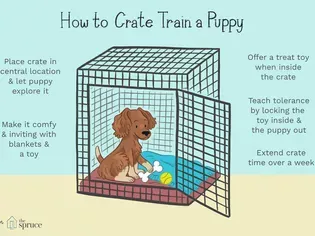Crate Training Your Puppy
Updated on 04/26/24

Ultimate Guide to Crate Training Your Puppy: A Step-by-Step Blueprint for Success
Introduction
Crate training is an essential foundation for a well-behaved, happy puppy. It provides a safe and secure space for your furry friend, reducing anxiety and promoting independence. While the process may seem daunting, with the right approach and consistency, you can easily master crate training your puppy. This comprehensive guide will walk you through each step, empowering you with the knowledge and techniques to foster a lifelong bond with your beloved companion.
Benefits of Crate Training
* Housebreaking: Crates limit your puppy's movement, making it easier to potty train.
* Anxiety Relief: When correctly introduced, crates create a sense of security, reducing stress during events like thunderstorms or fireworks.
* Independence: Crates give puppies a private space to retreat and relax, fostering self-reliance and reducing separation anxiety.
* Safety: Crates protect puppies from potentially dangerous situations when you're away.
* Travel Companion: Crates are essential for safe and comfortable travel with your furry friend.
Choosing the Right Crate
* Size: The crate should be large enough for your puppy to stand up, turn around, and lie down comfortably.
* Material: Choose a durable crate made from high-quality materials such as metal or plastic.
* Ventilation: Ensure the crate has adequate ventilation to prevent excessive heat build-up.
* Safety Features: Look for crates with rounded corners, secure locks, and a removable pan for easy cleaning.
Step-by-Step Crate Training
1. Positive Introduction
* Place the crate in a quiet area of your home and leave the door open.
* Scatter treats or toys inside the crate to encourage exploration.
* Reward your puppy for any positive interaction with the crate.
2. Short Duration Stays
* Once your puppy is comfortable entering the crate, gradually increase the duration of their stays.
* Start with a few minutes at a time and slowly work up to longer periods.
* Stay nearby and offer verbal praise and treats during these sessions.
3. Feeding Time
* Place your puppy's food bowl inside the crate.
* This will create a positive association between the crate and something enjoyable.
* Gradually move the bowl further into the crate as your puppy becomes more comfortable.
4. Nighttime Training
* Choose a designated spot for your puppy's crate in your bedroom or a nearby area.
* Establish a consistent bedtime routine and put your puppy in the crate.
* Ignore any whining or crying, as this will reward their attempts to escape.
5. Absence Training
* Start by leaving your puppy in the crate for short periods while you're in the same room.
* Gradually increase the duration of your absence, returning to reassure your puppy and offer treats.
* Never let your puppy out of the crate if they're whining or barking.
Tips for Success
* Consistency: Stick to the training schedule and avoid giving in to your puppy's whining.
* Positive Reinforcement: Reward your puppy generously for all desired behaviors during crate training.
* Avoid Punishment: Never use punishment as a training method. It will only damage your bond and make crate training more challenging.
* Address Anxiety: If your puppy exhibits excessive anxiety during crate training, consult with a veterinarian or certified dog trainer for guidance.
* Be Patient: Crate training requires patience and consistency. Don't get discouraged if your puppy takes time to adjust.
Common Mistakes to Avoid
* Using the Crate as Punishment: Crates should never be used as a form of punishment.
* Leaving Your Puppy in the Crate for Extended Periods: Puppies can only hold their bladders and bowels for a limited time. Overextended crate time can lead to accidents and health issues.
* Ignoring Whining and Crying: Whining and crying during crate training is likely a sign of anxiety or discomfort. Ignoring these behaviors can worsen the situation.
* Not Providing Bedding: Ensure the crate is comfortable for your puppy by providing soft bedding and a cozy blanket.
* Failing to Supervise: Always supervise your puppy during crate training to ensure their safety and well-being.
By following these steps and avoiding common mistakes, you can successfully crate train your puppy and reap the numerous benefits it offers. Remember, crate training is a journey that requires patience, consistency, and positive reinforcement. With time and dedication, you and your furry companion will develop an unbreakable bond that will last a lifetime.
Explore More Pets

Basic Training
Puppy and Baby Introductions

Working Dog Breeds
All About Search and Rescue Dogs

Dog Treatments
Puppy Vaginitis: Signs, Causes and Treatment

Dog Adoption
After More Than 1,200 Days in the Shelter, Coco Goes Home

Basic Training
How to Train Your Puppy to Go on Potty Pads

Hybrid Dog Breeds
The Difference Between a Mutt, Mixed Breed, or Designer Dog?

Dog Treatments
Nail Problems in Dogs

Puppies
7 Reasons Why Two Dogs Are Better Than One